Kaisai KUE-18HRG32X Installation guide
- Category
- Split-system air conditioners
- Type
- Installation guide
This manual is also suitable for

Owner’s Manual &
Installation Manual
IMPORTANT NOTE:
Read this manual carefully before installing
or operating your new air conditioning
unit. Make sure to save this manual for
future reference.
Please check the applicable models, technical
data, F-GAS(if any) and manufacturer information
from the “Owner's Manual - Product Fiche ”
in the packaging of the outdoor unit.
(European Union products only)
CEILING & FLOOR TYPE AIR CONDITIONER

Owner’s Manual
Table of Contents
Safety Precautions
............................................................................04
Unit Specifications and Features
1. Indoor unit display
2. Operating temperature
3. Other features
Care and Maintenance
Troubleshooting
........................................................09
............................................................................................................................................................09
...................................................................................................................................................11
....................................................................................................................................................................12
...................................................................13
..............................................................................15

Installation Manual
Accessories
Installation Summary
Unit Parts
Indoor Unit Installation
1. Select installation location
2. Hang indoor unit
3. Drill wall hole for connective piping
4. Connect drain hose
Outdoor Unit Installation
1. Select installation location
2. Install drain joint
3. Anchor outdoor unit
Refrigerant Piping Connection
A. Note on Pipe Length
B. Connection Instructions –Refrigerant Piping
1. Cut pipe
2. Remove burrs
3. Flare pipe ends
4. Connect pipes
Wiring
1. Outdoor Uint Wiring
2. Indoor Uint Wiring
Air Evacuation
1. Evacuation Instructions
2. Note on Adding Refrigerant
Test Run
.....................................................................................18
....................................................................19
........................................................................................20
.................................................................21
............................................................................................................................................21
..............................................................................................................................................................23
..........................................................................................................................25
..........................................................................................................................................................25
..................................................................
.
26
...........................................................................................................................................26
...............................................................................................................................................................27
.......................................................................................................................................................27
....................................................29
.....................................................................................................................................................29
........................................................................................................30
..........................................................................................................................................................................30
................................................................................................................................................................30
............................................................................................................................................................30
...............................................................................................................................................................31
......................................................................
...........................
32
........................................................................................................................................................33
............................................................................................................................................................34
...............................................................................37
.................................................................................................................................................37
.........................................................................................................................................38
.........................................................................................39

Safety
Precautions
Read Safety Precautions Before Operation and Installation
The seriousness of potential damage or injuries is classified as either a WARNING or CAUTION.
Incorrect installation due to ignoring instructions can cause serious damage or injury.
WARNING
This appliance can be used by children aged from 8 years and above and persons with reduced
This appliance is not intended for use by persons(including children) with reduced physical, sensory
or mental capabilities, or lack of experience and knowledge, unless they have been given supervision
or instruction concerning use of the appliance by a person responsible for their safety. Children
should be supervised to ensure that they do not play with the appliance.
physical, sensory or mental capabilities or lack of experience and knowledge if they have been given
supervision or instruction concerning use of the appliance in a safe way and understand the hazards
involved. Children shall not play with the appliance. Cleaning and user maintenance shall not be
made by children without supervisionEuropean Union countries
.
WARNINGS FOR PRODUCT USE
•
If an abnormal situation arises (like a burning smell), immediately turn o the unit and disconnect
the power. Call your dealer for instructions to avoid electric shock, re or injury.
•
Do not
insert fingers, rods or other objects into the air inlet or outlet. This may cause injury, since
the fan may be rotating at high speeds.
•
Do not
use flammable sprays such as hair spray, lacquer or paint near the unit. This may cause
fire or combustion.
•
Do not
operate the air conditioner in places near or around combustible gases. Emitted gas may
collect around the unit and cause explosion.
•
Do not
•
•
Do not
expose your body directly to cool air for a prolonged period of time.
•
•
If the air conditioner is used together with burners or other heating devices, thoroughly ventilate
the room to avoid oxygen deficiency.
Safety Precautions
Do not
allow children to play with the air conditioner. Children must be supervised around the
unit at all times.
operate your air conditioner in a wet room such as a bathroom or laundry room. Too
much exposure to water can cause electrical components to short circuit.
In certain functional environments, such as kitchens, server rooms, etc., the use of specially
designed air-conditioning units is highly recommended.
Page 4
WARNING
This symbol indicates the possibility
of personnel injury or loss of life.
CAUTION
This symbol indicates the possibility of
property damage or serious consequences.

Safety
Precautions
• Do not
clean the air conditioner with combustible cleaning agents. Combustible cleaning agents
can cause re or deformation.
CLEANING AND MAINTENANCE WARNINGS
•
Turn o the device and disconnect the power before cleaning. Failure to do so can cause
electrical shock.
• Do not
clean the air conditioner with excessive amounts of water.
CAUTION
•
Turn o the air conditioner and disconnect the power if you are not going to use it for a long time.
•
Turn o and unplug the unit during storms.
•
Make sure that water condensation can drain unhindered from the unit.
• Do not
operate the air conditioner with wet hands. This may cause electric shock.
• Do not
use device for any other purpose than its intended use.
• Do not
climb onto or place objects on top of the outdoor unit.
• Do not
allow the air conditioner to operate for long periods of time with doors or windows open,
or if the humidity is very high.
ELECTRICAL WARNINGS
•
Only use the specified power cord. If the power cord is damaged, it must be replaced by the
manufacturer
, its service agent or similarly qualied persons in order to avoid a hazard.
•
Keep power plug clean. Remove any dust or grime that accumulates on or around the plug. Dirty
plugs can cause re or electric shock.
•
•
•
•
•
•
•
Do not
pull power cord to unplug unit. Hold the plug firmly and pull it from the outlet. Pulling
directly on the cord can damage it, which can lead to fire or electric shock.
Do not
modify the length of the power supply cord or use an extension cord to power the unit.
Do not
share the electrical outlet with other appliances. Improper or insucient power supply
can cause re or electrical shock.
If connecting power to xed wiring, an all-pole disconnection device which has at least 3mm
clearances in all poles, and have a leakage current that may exceed 10mA, the residual current
device(RCD) having a rated residual operating current not exceeding 30mA, and disconnection
must be incorporated in the xed wiring in accordance with the wiring rules.
For all electrical work, follow all local and national wiring standards, regulations, and the
Installation Manual. Connect cables tightly, and clamp them securely to prevent external forces
from damaging the terminal. Improper electrical connections can overheat and cause re, and may
also cause shock.
All electrical connections must be made according to the Electrical Connection
Diagram located on the panels of the indoor and outdoor units.
All wiring must be properly arranged to ensure that the control board cover can close properly. If
the control board cover is not closed properly, it can lead to corrosion and cause the connection
points on the terminal to heat up, catch re, or cause electrical shock.
The product must be properly grounded at the time of installation, or electrical shock may occur.
TAKE NOTE OF FUSE SPECIFICATIONS
The air conditioner’s circuit board (PCB) is designed with a fuse to provide overcurrent protection.
The specifications of the fuse are printed on the circuit board ,such as :
T5A/250VAC, T10A/250VAC, T20A/250VAC, T30A/250VAC etc.
NOTE: For the units with R32 or R290 refrigerant , only the blast-proof ceramic fuse can be used.
Page 5

Safety
Precautions
WARNINGS FOR PRODUCT INSTALLATION
1.
Installation must be performed by an authorized dealer or specialist. Defective installation can
cause water leakage, electrical shock, or re.
2.
Installation must be performed according to the installation instructions. Improper installation
can cause water leakage, electrical shock, or re.
In North America,installation must be performed in accordance with the requirement of NEC
and CEC by authorized personnel only.)
3.
Contact an authorized service technician for repair or maintenance of this unit. This appliance
shall be installed in accordance with national wiring regulations.
4.
Only use the included accessories, parts, and specied parts for installation. Using non-standard
parts can cause water leakage, electrical shock, re, and can cause the unit to fail.
5.
6.
Install the unit in a rm location that can support the unit’s weight. If the chosen location cannot
support the unit’s weight, or the installation is not done properly, the unit may drop and cause
serious injury and damage.
7.
8.
9.
10.
11.
Do not turn on the power until all work has been completed.
When moving or relocating the air conditioner, consult experienced service technicians for
disconnection and reinstallation of the unit.
How to install the appliance to its support, please read the information for details in "indoor unit
installation" and "outdoor unit installation" sections .
For units that have an auxiliary electric heater, do not install the unit within 1 meter (3 feet) of
any combustible materials.
Do not
install the unit in a location that may be exposed to combustible gas leaks. If
combustible
gas accumulates around the unit, it may cause re.
Install drainage piping according to the instructions in this manual. Improper drainage may
cause water damage to your home and property.
Note about Fluorinated Gasses(Not applicable to the unit using R290 Refrigerant)
1.
This air-conditioning unit contains fluorinated greenhouse gasses. For specic information on the
type of gas and the amount, please refer to the relevant label on the unit itself or
the
“Owner's Manual - Product Fiche ” in the packaging of the outdoor unit. (European
Union products only)
.
2.
Installation, service, maintenance and repair of this unit must be performed by a certified
technician.
3.
Product uninstallation and recycling must be performed by a certified technician.
4.
For equipment that contains uorinated greenhouse gases in quantities of 5 tonnes of CO2
equivalent or more, but of less than 50 tonnes of CO2 equivalent, If the system has a leak-
detection system installed, it must be checked for leaks at least every 24 months.
5.
When the unit is checked for leaks, proper record-keeping of all checks is strongly recommended.
Page 6

Safety
Precautions
WARNING for Using R32/R290 Refrigerant
When ammable refrigerant are employed, appliance shall be stored in a well -ventilated area
where the room size corresponds to the room area as speciec for operation.
For R32 frigerant models:
Appliance shall be installed, operated and stored in a room with a oor area larger than
X m²
.
Appliance shall not be installed in an unvertilated space, if that space is smaller than
X m²
(Please see the following form)
.
Reusable mechanical connectors and ared joints are not allowed indoors.
(EN Standard Requirements).
Mechanical connectors used indoors shall have a rate of not more than 3g/year at 25%
of the maximum allowable pressure. When mechanical connectors are reused indoors,
sealing parts shall be renewed. When ared joints are reused indoors, the are part
shall be re-fabricated. (UL Standard Requirements)
When mechanical connectors are reused indoors, sealing parts shall be renewed. When
ared joints are reused indoors, the are part shall be re-fabricated.
(IEC Standard Requirements)
Mechanical connectors used indoors shall comply with ISO 14903.
Page 7
Amount of refrigerant
to be charged (kg) maximum installation
height (m) Minimum room
area (m²)
<
2.048 1.8m 4
<
2.048 0.6m 35
2.048-3.0 1.8m 8
2.048-3.0 0.6m 80
>3.0 1.8m 9
>3.0
Model
(Btu/h)
<
30000
<
30000
30000-48000
30000-48000
>48000
>48000 0.6m 80

Safety
Precautions
Page 8
European Disposal Guidelines
This appliance contains refrigerant and other potentially hazardous materials. When disposing of
this appliance, the law requires special collection and treatment. Do not
dispose of this product as
household waste or unsorted municipal waste.
When disposing of this appliance, you have the following options:
• Dispose of the appliance at designated municipal electronic waste collection facility.
• When buying a new appliance, the retailer will take back the old appliance free of charge.
• The manufacturer will take back the old appliance free of charge.
• Sell the appliance to certied scrap metal dealers.
Special notice
Disposing of this appliance in the forest or other natural surroundings endangers your health and is bad
for the environment. Hazardous substances may leak into the ground water and enter the food chain.
Correct Disposal of This Product
(Waste Electrical & Electronic Equipment)
This marking shown on the product or its literature, indicates that waste electrical and eletrical
equipment should not be mixed with general household waste.

Page 9
Unit Specifications and Features
Unit
Specifications
and Features
Indoor unit display
Air inlet
Display panel
Air outlet Louver
Installation part
Infrared receiver
ALARMDEF./FAN
MANUAL OPERATION TIMER
(A)
(B)
(C)
Infrared receiver LED display
MANUAL
Infrared receiver
(D)
(E)
(F)
Infrared receiver
MANUAL
ALARM
DEF./FAN
OPERATION TIMER
Infrared receiver
LED display
MANUAL TIMER
ALARM
OPERATION
DEF./FAN
Infrared receiver
MANUAL
TIMER ALARM
OPERATION DEF./FAN
Illustrations in this manual are for explanatory purposes. The actual shape of your indoor unit may be
slightly dierent. The actual shape shall prevail.
NOTE: Dierent models have dierent display panel. Not all the indicators describing below are available
for the air conditioner you purchased. Please check the indoor display panel of the unit you purchased.
This display panel on the indoor unit can be used to operate the unit in case the remote control has
been misplaced or is out of batteries.

Unit
Specifications
and Features
Page 10
ALARM
DEF./FAN
DEF./FAN
(G) (H)
Infrared receiver LED display
MANUAL
Infrared receiver LED display
• MANUAL button :
This button selects the mode in the following order: AUTO, FORCED COOL, OFF.
FORCED COOL mode :
In FORCED COOL mode, the Operation light flashes. The system will then
turn to AUTO after it has cooled with a high wind speed for 30 minutes. The remote control will be
disabled during this operation.
OFF mode : The unit turns o.
• OPERATION
OPERATION
Operation indicator :
• Timer indicator : TIMER
TIMER
• PRE-DEF indicator :
(pre-heating/defrost)
• Alarm indicator :
• Func button :
ALARM

Unit
Specifications
and Features
Page 11
Operating temperature
When your air conditioner is used outside of the following temperature ranges, certain safety
protection features may activate and cause the unit to disable.
To further optimize the performance of your unit, do the following:
• Keep doors and windows closed.
• Limit energy usage by using TIMER ON and TIMER OFF functions.
• Do not block air inlets or outlets.
• Regularly inspect and clean air lters.
NOTE: Room relative humidity less than 80%. If the air conditioner operates in excess of this
gure, the surface of the air conditioner may attract condensation. Please sets the vertical air
ow louver to its maximum angle (vertically to the oor), and set HIGH fan mode.
Room
Temperature 17°C-32°C (62°F-90°F) 0°C-30°C
(32°F-86°F) 10°C-32°C (50°F-90°F)
Outdoor
Temperature
18°C-43°C (64°F-109°F)
-7°C-24°C
(19°F-75°F)
11°C-43°C (52°F-109°F)
-7°C-43°C (19°F-109°F)
(For models with low-temp cooling systems) 18°C-43°C (64°F-109°F)
18°C-52°C (64°F-126°F)
(For special tropical models) 18°C-52°C (64°F-126°F)
(For special tropical models)
COOL mode HEAT mode DRY mode
COOL mode HEAT mode DRY mode
Room Temperature 17°C - 32°C
(62°F - 90°F)
0°C - 30°C
(32°F - 86°F)
10°C - 32°C
(50°F - 90°F)
Outdoor
Temperature
0°C - 50°C
(32°F - 122°F)
-15°C - 24°C
(5°F - 75°F)
0°C - 50°C
(32°F - 122°F)
0°C - 52°C
(32°F - 126°F)
(For special
tropical models)
0°C - 52°C
(32°F - 126°F)
(For special
tropical models)
-15°C - 50°C
(5°F - 122°F)
(For models with
low temp. cooling
systems.)
FOR OUTDOOR UNITS
WITH AUXILIARY
ELECTRIC HEATER
Inverter Split Type
Fixed-speed Type
When outside
temperature is below 0°C
(32°F ), we strongly
recommend keeping the
unit plugged in at all
time to ensure smooth
ongoing performance.

Page 12
Unit
Specifications
and Features
Default Setting
When the air conditioner restarts after a power
failure, it will default to the factory settings
(AUTO mode, AUTO fan, 24°C (76°F)). This
may cause inconsistencies on the remote
control and unit panel. Use your remote
control to update the status.
Auto-Restart (some models)
In case of power failure, the system will
immediately stop. When power returns, the
Operation light on the indoor unit will flash. To
restart the unit, press the ON/OFF button on
the remote control. If the system has an auto
restart function, the unit will restart using the
same settings.
Louver Angle Memory Function
(some models)
Some models are designed with a louver angle
memory function. When the unit restarts after a
power failure, the angle of the horizontal louvers
will automatically return to the previous position.
The angle of the horizontal louver should not be
set too small as condensation may form and drip
into the machine. To reset the louver, press the
manual button, which will reset the horizontal
louver settings.
Refrigerant Leak Detection System
(some models)
Other features
The indoor unit will automatically display “EC”
or “EL0C”or ash LEDS (model dependent )
when it detects refrigerant leakage.

Page 13
Care and Maintenance
Cleaning Your Indoor Unit
BEFORE CLEANING OR
MAINTENANCE
ALWAYS TURN OFF YOUR AIR CONDITIONER
SYSTEM AND DISCONNECT ITS POWER SUPPLY
BEFORE CLEANING OR MAINTENANCE.
CAUTION
Only use a soft, dry cloth to wipe the unit clean.
If the unit is especially dirty, you can use a cloth
soaked in warm water to wipe it clean.
•
Do not
use chemicals or chemically treated
cloths to clean the unit
•
Do not use benzene, paint thinner,
polishing powder or other solvents to clean
the unit. They can cause the plastic surface
to crack or deform.
•
Do not use water hotter than 40°C (104°F)
to clean the front panel. This can cause the
panel to deform or become discolored.
Cleaning Your Air Filter
A clogged air conditioner can reduce the cooling
efficiency of your unit, and can also be bad for
your health. Make sure to clean the filter once
every two weeks.
WARNING: DO NOT REMOVE OR
CLEAN THE FILTER BY YOURSELF
Removing and cleaning the filter can be
dangerous. Removal and maintenance must be
performed by a certified technician.
1. Open the air intake with a screwdriver or
similar tool. Detach the grille from the main
unit by holding the grille at a 45° angle,
lifting it up slightly, and then pulling the grille
forward.
2. Take out the air lter. (applicable to
3.2~10.5KW air conditioners only).
If using a vacuum
cleaner, the inlet side
should face the vacuum.
If using water, the inlet
side should face down
and away from the water
stream.
6. Rinse the lter with clean water and allow
it to air-dry.
DO NOT
let the lter dry in
direct sunlight.
7. Reinstall the lter.
4. Remove the air lter.
5. Clean the air lter by vacuuming the surface
or washing it in warm water with mild
detergent.
3. Directly pull out the air lter from the air inlet
as indicated (applicable to 14~16KW air
conditioners only).
Care and
Maintenance
Air Inlet
Air lter

Page 14
Care and
Maintenance
Maintenance –
Long Periods of Non-Use
If you plan not to use your air conditioner for an
extended period of time, do the following:
Clean all lters Turn on FAN function until
unit dries out completely
Turn o the unit and
disconnect the power
Remove batteries
from remote control
Maintenance –
Pre-Season Inspection
After long periods of non-use, or before periods
of frequent use, do the following:
Check for damaged wires Clean all lters
Check for leaks Replace batteries
Make sure nothing is blocking all air inlets and outlets
CAUTION
•
Before changing the lter or cleaning,
turn o the unit and disconnect its power
supply.
•
When removing lter, do not touch metal
parts in the unit. The sharp metal edges can
cut you.
•
Do not use water to clean the inside of the
indoor unit. This can destroy insulation and
cause electrical shock.
•
Do not expose lter to direct sunlight when
drying. This can shrink the lter.
CAUTION
•
Any maintenance and cleaning of outdoor
unit should be performed by an authorized
dealer or a licensed service provider.
•
Any unit repairs should be performed
by an authorized dealer or a licensed
service provider.

Page 15
Troubleshooting
Common Issues
The following problems are not a malfunction and in most situations will not require repairs.
Issue Possible Causes
Unit does not turn
on when pressing
ON/OFF button
The Unit has a 3-minute protection feature that prevents the unit from overloading.
The unit cannot be restarted within three minutes of being turned o.
The unit may change its setting to prevent frost from forming on the unit.
Once the temperature increases, the unit will start operating in the
previously selected mode again.
The set temperature has been reached, at which point the unit turns o the
compressor. The unit will continue operating when the temperature
fluctuates again.
The indoor unit
emits white mist
In humid regions, a large temperature dierence between the room’s air
and the conditioned air can cause white mist.
Both the indoor and
outdoor units emit
white mist
When the unit restarts in HEAT mode after defrosting, white mist may be
emitted due to moisture generated from the defrosting process.
Troubleshooting
The unit changes from
COOL/HEAT mode to
FAN mode
The indoor unit makes
noises
A rushing air sound may occur when the louver resets its position.
A squeaking sound may occur after running the unit in HEAT mode due to
expansion and contraction of the unit’s plastic parts.
Both the indoor unit
and outdoor unit make
noises
Low hissing sound during operation: This is normal and is caused by refrigerant
gas flowing through both indoor and outdoor units.
Low hissing sound when the system starts, has just stopped running, or is
defrosting: This noise is normal and is caused by the refrigerant gas stopping or
changing direction.
Squeaking sound: Normal expansion and contraction of plastic and metal parts
caused by temperature changes during operation can cause squeaking noises.
SAFETY PRECAUTIONS
If any of the following conditions occurs, turn o your unit immediately!
• The power cord is damaged or abnormally warm
• You smell a burning odor
• The unit emits loud or abnormal sounds
• A power fuse blows or the circuit breaker frequently trips
• Water or other objects fall into or out of the unit
DO NOT ATTEMPT TO FIX THESE YOURSELF! CONTACT AN AUTHORIZED
SERVICE PROVIDER IMMEDIATELY!
Cooling and Heating Models: If the Operation light and PRE-DEF (Pre-heating/
Defrost) indicators are lit up, the outdoor temperature is too cold and the unit’s
anti-cold wind is activated in order to defrost the unit.
In Cooling-only Models: If the “Fan Only” indicator is lit up, the outdoor
temperature is too cold and the unit’s anti-freeze protection is activated in
order to defrost the unit.
A squeaking sound is heard when the system is OFF or in COOL mode. The
noise is also heard when the drain pump (optional) is in operation.

Page 16
Troubleshooting
Issue Possible Causes
The outdoor unit
makes noises
The unit will make dierent sounds based on its current operating mode.
Dust is emitted from
either the indoor or
outdoor unit
The unit may accumulate dust during extended periods of non-use, which will be
emitted when the unit is turned on. This can be mitigated by covering the unit during
long periods of inactivity.
The unit emits a
bad odor
The unit may absorb odors from the environment (such as furniture, cooking,
cigarettes, etc.) which will be emitted during operations.
The unit’s filters have become moldy and should be cleaned.
The fan of the outdoor
unit does not operate
During operation, the fan speed is controlled to optimize product operation.
NOTE: If problem persists, contact a local dealer or your nearest customer service center. Provide
them with a detailed description of the unit malfunction as well as your model number.
Troubleshooting
When troubles occur, please check the following points before contacting a repair company.
Problem Possible Causes Solution
Poor Cooling
Performance
Temperature setting may be higher
than ambient room temperature Lower the temperature setting
The heat exchanger on the indoor
or outdoor unit is dirty
Clean the aected heat exchanger
The air lter is dirty Remove the filter and clean it according to
instructions
The air inlet or outlet of either
unit is blocked
Turn the unit o, remove the obstruction
and turn it back on
Doors and windows are open Make sure that all doors and windows are
closed while operating the unit
Excessive heat is generated
by sunlight
Close windows and curtains during periods
of high heat or bright sunshine
Too many sources of heat in the
room (people, computers,
electronics, etc.)
Reduce amount of heat sources
Low refrigerant due to leak
or long-term use
Check for leaks, re-seal if necessary and
top o refrigerant

Page 17
Troubleshooting
Problem Possible Causes Solution
The unit is not
working
Power failure Wait for the power to be restored
The power is turned o Turn on the power
The fuse is burned out Replace the fuse
Remote control batteries are dead
Replace batteries
The Unit’s 3-minute protection
has been activated
Wait three minutes after restarting
the unit
Timer is activated Turn timer o
The unit starts and
stops frequently
There’s too much or too little
refrigerant in the system
Check for leaks and recharge the
system with refrigerant.
Incompressible gas or moisture
has entered the system.
Evacuate and recharge the system
with refrigerant
The compressor is broken Replace the compressor
The voltage is too high or
too low Install a manostat to regulate the
voltage
Poor heating
performance
The outdoor temperature is
extremely low
Use auxiliary heating device
Cold air is entering through
doors and windows
Make sure that all doors and
windows are closed during use
Low refrigerant due to leak or
long-term use
Check for leaks, re-seal if necessary
and top o refrigerant
Indicator lamps
continue flashing The unit may stop operation or continue to run safely. If the indicator
lamps continue to flash or error codes appear, wait for about 10
minutes. The problem may resolve itself.
If not, disconnect the power, then connect it again. Turn the unit on.
If the problem persists, disconnect the power and contact your nearest
customer service center.
Error code appears and
begins with the letters
as the following in the
window display of
indoor unit:
E(x), P(x), F(x)
EH(xx), EL(xx), EC(xx)
PH(xx), PL(xx), PC(xx)
•
•
•
NOTE: If your problem persists after performing the checks and diagnostics above,
turn o your unit immediately and contact an authorized service center.
System circuit is blocked Determine which circuit is blocked and
replace the malfunctioning piece of
equipment

Page 18
Accessories
The air conditioning system comes with the following accessories. Use all of the installation parts and
accessories to install the air conditioner. Improper installation may result in water leakage, electrical
shock and re, or cause the equipment to fail. The items are not included
with the air conditioner must be purchased separately.
Name
Shape Quantity(PC)
Remote controller
(
some models
)
Fixing screw for
remote controller
holder(
some models
)
Remote controller
holder(
some models
)
Manual
Parts you must purc hase
separately. Consult the dealer
about the proper pipe size of
the unit you purchased.
Connecting pipe
assembly
Liquid side
Gas side
Φ6.35(1/4 in)
Φ9.52(3/8in)
Φ12.7(1/2in)
Φ9.52(3/8in)
Φ12.7(1/2in)
Φ 16(5/8in)
Φ 19(3/4in)
Φ 22(7/8in)
2~4
1
Name of Accessories
Q‘ty(pc) Shape
1
1
1
1
1
1
Name of Accessories
Q‘ty(pc) Shape
1
2
1
2
Battery(
some models
)
Soundproof/insulation
sheath (some models)
Outlet pipe sheath
(some models)
Outlet pipe clasp
(some models)
Drain joint
(some models)
Seal ring
(some models)
Magnetic ring (wrap
the electric wires S1
& S2 ( P & Q & E )
around the magnetic
ring twice)
(some models)
Magnetic ring (Hitch
it on the connective
cable between indoor
unit and outdoor unit
after installation.)
(some models)
Conduit installation
plate (some models)
S1&S2(P&Q&E)
Copper nut 2
Accessories
Varies
by model

Install the outdoor unitInstall the drainpipe
L(L1) N(L2)
123
4
5
MC MC
6
7
Install the indoor unit
Evacuate the refrigeration
system Connect the wires Connect the refrigerant
pipes
Perform a test run
Page 19
Installation Summary
Installation Summary

Page 20
Unit Parts
NOTE ON ILLUSTRATIONS
Illustrations in this manual are for explanatory purposes. The actual shape of your indoor
unit may be slightly dierent. The actual shape shall prevail.
NOTE: The installation must be performed in accordance with the requirement of local and
national standards. The installation may be slightly dierent in dierent areas.
Unit Parts
Display panel
Drain pipe
Installation part
Connecting pipe
Air inlet
Air outlet
Remote controller
Air ow louver (at air outlet)
Air inlet (with air lter in it)
1
24
3
6
7
8
8
9
5
1
2
3
4
5
6
7
8
9
Page is loading ...
Page is loading ...
Page is loading ...
Page is loading ...
Page is loading ...
Page is loading ...
Page is loading ...
Page is loading ...
Page is loading ...
Page is loading ...
Page is loading ...
Page is loading ...
Page is loading ...
Page is loading ...
Page is loading ...
Page is loading ...
Page is loading ...
Page is loading ...
Page is loading ...
Page is loading ...
Page is loading ...
-
 1
1
-
 2
2
-
 3
3
-
 4
4
-
 5
5
-
 6
6
-
 7
7
-
 8
8
-
 9
9
-
 10
10
-
 11
11
-
 12
12
-
 13
13
-
 14
14
-
 15
15
-
 16
16
-
 17
17
-
 18
18
-
 19
19
-
 20
20
-
 21
21
-
 22
22
-
 23
23
-
 24
24
-
 25
25
-
 26
26
-
 27
27
-
 28
28
-
 29
29
-
 30
30
-
 31
31
-
 32
32
-
 33
33
-
 34
34
-
 35
35
-
 36
36
-
 37
37
-
 38
38
-
 39
39
-
 40
40
-
 41
41
Kaisai KUE-18HRG32X Installation guide
- Category
- Split-system air conditioners
- Type
- Installation guide
- This manual is also suitable for
Ask a question and I''ll find the answer in the document
Finding information in a document is now easier with AI
Related papers
-
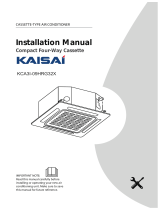 SystemAir SYSPLIT CASSETTE 18 EVO HP Q Installation guide
SystemAir SYSPLIT CASSETTE 18 EVO HP Q Installation guide
-
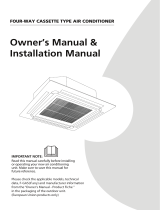 AlpicAir ACI-53HRDC1A User manual
AlpicAir ACI-53HRDC1A User manual
-
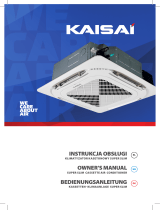 Kaisai KCD-36HRG32X Operating instructions
Kaisai KCD-36HRG32X Operating instructions
-
 Kaisai KUE-24HRF32 Installation guide
Kaisai KUE-24HRF32 Installation guide
-
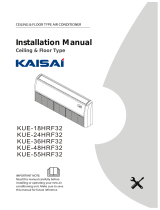 Kaisai ceiling floor R32 Installation guide
Kaisai ceiling floor R32 Installation guide
-
 Kaisai KGE-18GRHI Installation guide
Kaisai KGE-18GRHI Installation guide
-
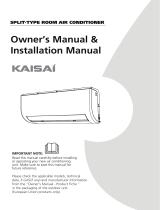 Kaisai KRX-09PEGI Installation guide
Kaisai KRX-09PEGI Installation guide
-
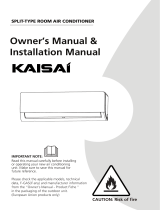 Kaisai KSH-12HRHI Installation guide
Kaisai KSH-12HRHI Installation guide
-
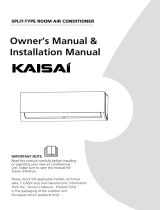 Kaisai KWC-18CGI Installation guide
Kaisai KWC-18CGI Installation guide
-
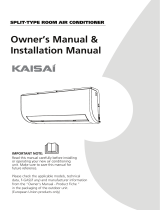 Kaisai KRX-09AEGI Installation guide
Kaisai KRX-09AEGI Installation guide
Other documents
-
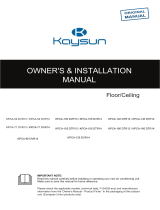 Kaysun Floor/Ceiling Current Loop User manual
Kaysun Floor/Ceiling Current Loop User manual
-
Frigicoll KCI-35 DR13 User manual
-
Kaysun Ducts Current Loop User manual
-
Cooper & Hunter CH-16MMC-230VI Installation guide
-
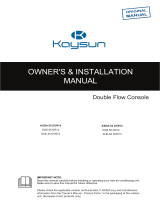 Kaysun Double Flow Console User manual
Kaysun Double Flow Console User manual
-
COMFORT-AIRE B-VMH24CU-1 Owner's manual
-
Klimaire KDIS060-H2G1 User manual
-
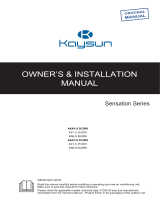 Kaysun Sensation User manual
Kaysun Sensation User manual
-
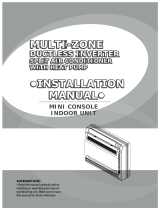 Ramsond RHDZ-27-18FC/18WM User manual
Ramsond RHDZ-27-18FC/18WM User manual
-
MRCOOL Advantage Series 4th Gen Install Manual






















































